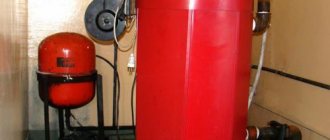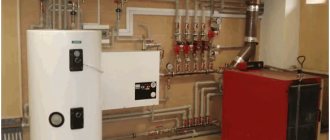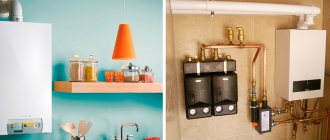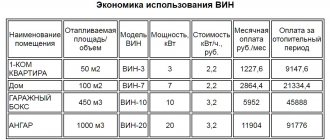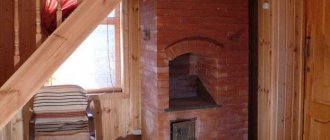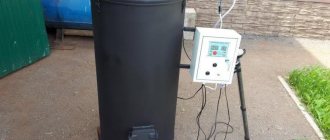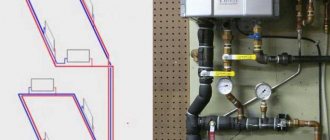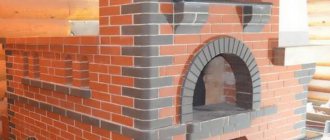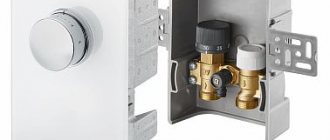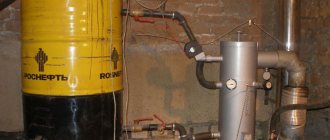- Waste oil boiler: a reliable and budget option for heating a room
- What is a waste oil boiler?
- How does an exhaust boiler work?
- Types of waste oil boilers
- Characteristics of a waste oil heating boiler
- Subtleties of the process of creating a boiler for testing with your own hands
- Making your own waste oil boiler with a water circuit
- Oil options for waste oil boilers
- Review of Russian-made boilers using waste oil
- Expensive domestically produced waste oil boilers
- Finnish boilers for private homes using waste oil
- European manufacturers of heating boilers are undergoing testing
- Other oil boiler manufacturers
- Video: boilers using waste oil (waste oil)
Waste oil boiler: a reliable and budget option for heating a room
A profitable option for supplying heating to the room and providing hot water is a waste oil boiler. The device is characterized by a simple design, which allows you to make it yourself. This will help you save additional money. If this possibility is excluded, you can purchase a boiler for factory assembly testing. Currently, the product range is presented in a wide variety.
Burner for testing: varieties, device, how to make it yourself (read more)
The boiler can use different types of used oil, which is characterized by an abundance of various impurities.
Boiler houses undergoing testing from
offers boiler houses for the production of any power in a stationary or mobile version. For you, we will create a boiler house project, manufacture and install a boiler house in accordance with the requirements of your enterprise, as well as the wishes and rules that regulate the heat and power industry in Russia.
We offer, in particular, the most common type of turnkey boiler houses - factory-assembled block-modular units, which will be delivered to the heated facility in almost finished form. All that remains is to install the equipment and carry out commissioning work.
Having all the required permits and certificates, as well as significant operational experience, we can guarantee that waste oil boilers from Alliansteplo will be installed on time in compliance with all legal requirements.
What is a waste oil boiler?
Today, heating equipment that operates during mining is very popular. This is due to a number of distinctive advantages of the device. First of all, this is the low cost of installation and the availability of fuel, which can be purchased for a nominal fee. Exhaust heating does not require the use of resources in the form of electricity and gas, which makes it economically profitable.
Despite its many advantages, the development boiler also has its disadvantages.
Note! Recycling waste products in full has a beneficial effect on the environment, eliminating the disposal of oil and its release onto the ground and into water bodies.
When the boiler is set up correctly, the waste oil is burned completely, which prevents the formation of toxic combustion products. The device consists of a minimum number of parts, which can be seen in boiler diagrams. This increases the reliability and durability of the structure. It does not take much time to heat up the boiler. Forced convection helps to quickly increase the temperature in the room.
Despite its many advantages, the boiler during testing also has disadvantages. When the device operates, moisture evaporates from the air and oxygen is burned, which negatively affects human health. Therefore, the boiler should be located in a non-residential area with a good ventilation system. Devices during mining quickly become dirty. This especially applies to the plasma bowl and chimney.
For such a boiler, different types of waste oil can be used, which is characterized by an abundance of various impurities. Therefore, to ensure a long period of operation of the device, a filter should be installed in the place where oil is supplied to the boiler, which must be changed as it becomes dirty.
The waste oil boiler should be located in a non-residential area with a good ventilation system.
How does an exhaust boiler work?
Boilers for a private home using waste oil, as well as for a garage, workshop or industrial premises, have a simple design. They consist of two chamber compartments: an evaporation chamber and a combustion chamber. In the first compartment, the process of preparing used oil for combustion is carried out. In the second, it is burned. The principle of operation of the device is as follows.
From a container with used oil, the pump supplies the substance to the evaporation chamber, which is located in the lower part of the device. It maintains the required temperature, sufficient for heating and subsequent evaporation of the waste. Oil vapor rises to the upper zone of the housing, where the combustion chamber is located. It is additionally equipped with an air duct in the form of a pipe with holes. Using a fan, air is supplied through an air duct into the chamber, where it is mixed with oil vapor. The resulting mixture burns without a residue.
The heat exchanger distributes the resulting heat. The resulting combustion products enter the chimney. A mandatory process is preheating of the waste. Oil contains many impurities; under the influence of a certain temperature, the substance decomposes into simple carbons, which are subsequently burned. As a result, water vapor, nitrogen and gas are formed, which are harmless to the body.
Waste oil boilers have a simple design.
Complete oxidation of carbohydrates is possible only at a temperature of 600 °C. If this value is not observed, the combustion process produces many toxic substances that are extremely dangerous to human health.
Production of a boiler for development
Almost anyone can make a working boiler. There are many designs and methods, all of them have been tested in practice and are widely used. There are two main designs, let's look at them.
Drawings of heating units
In the first case, the boiler consists of two chambers connected to each other by a pipe with holes. The evaporation compartment is located in the lower chamber, where open combustion of the waste occurs. Afterburning occurs in a pipe with holes into which air is supplied naturally. After the pipe there is a second chamber, in which the speed of movement of fuel vapors decreases.
The partition in the upper compartment also serves for complete oxidation and connection with nitrogen. A chimney is installed higher, it serves to remove combustion products and additional draft. Light the boiler using a rag soaked in gasoline or kerosene. In the lower compartment there is a special damper that regulates the air supply to the first combustion chamber. For hot water supply and heating systems, a water jacket is installed in the second compartment. It is important to leave a gap between the pipe and the tank of at least 70 mm.
The second manufacturing method involves more economical use of fuel.
The power of the device can reach 15 kW.
The design contains a turbine for forced air supply. Increased boost burns the fuel mixture more efficiently. The waste tank is taken out separately and a valve is installed on it to regulate the oil supply to the boiler or stop it completely. As in the first case, the central pipe is equipped with slots or holes for efficient combustion of fuel vapors. The waste combustion products are also removed through the chimney; when installing it, sharp corners and sharp turns should not be allowed. Recommended length is at least 4 m.
This design allows you to comply with all safety requirements, and also makes it possible to easily install water elements of the heating system. The most economical.
Necessary materials
When making a waste oil boiler, the following materials may be needed:
- Gas cylinder with a volume of at least 50 l
- Metal pipes with diameters of 100 mm, thickness of 3 mm and 6 mm
- Metal sheets from 3 mm to 5 mm thick
- Car brake disc
- Steel pipe with a diameter of 15 mm
- Fireproof Fuel Supply Hose
- Ball valve
- Oil tank
- Steel cover, at least 5 mm thick
- Steel sheet no thinner than 3 mm, for water jacket
- Set of pipes for connections
It is recommended to use special products to protect against rust; this will extend the life of the boiler. In places where pipes are connected, paste and tow are used to increase sealing.
Tools used for manufacturing
During work you may need a variety of tools:
- For welding connections, transformer machines or inverters are used, since such connections are subject to increased requirements.
- Drill kit and hand electric drill to make holes for mounting and torch.
- Set of pipe thread dies.
- Grinding machine, two wheels for it: cutting and cleaning.
- Tape measure, metal ruler, gas wrench and device for marking on metal.
Before starting work, it is recommended to secure the welding site, and also use coolant when drilling.
Instructions for making a boiler for testing yourself
In order to make a waste oil boiler with your own hands, you must follow the following instructions:
- The gas cylinder must first be emptied. The valve is turned off from above, the container is turned over and all the contents are drained. The cylinder is washed with water, only then can welding and cutting work be carried out.
- Two openings are cut out in the container, leaving a strip of at least 50 mm between them. The upper compartment is made larger so that firewood can be loaded into it. The cut parts are not thrown away; these will be hatches for loading fuel.
- Hinges are welded to openings and hatches.
- A ring equal to the inner diameter of the cylinder is cut out of a sheet of steel 4 mm thick, and a hole is made in it slightly larger than the diameter of the burner (100 mm). Serves as a partition between the combustion compartment and the heat exchanger.
- Cut a piece 200 mm long from the steel pipe, make holes on the entire surface for a length of 95 mm.
- The burner blank is inserted into the previously made ring up to the holes and welded.
- The partition is installed at the level of the upper combustion compartment.
- A brake disc from a passenger car can serve as a blank for the evaporator. It is first necessary to close all the technological holes from the bottom and top; for this, two rings are cut out of a sheet of steel, one will be the bottom, and the other will be the lid. Then they are welded, a hole is made in the cover for subsequent installation of the coupling.
- A 150 mm long section is cut from the pipe, then you need to cut it lengthwise and slightly move the walls apart to 3-4 mm. Afterwards, the workpiece is welded to the combustion bowl and attached to the burner.
- A water jacket is formed from a steel sheet around the boiler, and everything should be scalded with a continuous seam.
- Pipes for draining and supplying water are installed at the bottom and top.
- Mount the chimney in the lid and install it on the boiler.
- A hole is made in the wall of the gas cylinder, a tube is inserted into it at an angle, its end is placed above the fuel supply window. After adjusting the extension length, the tube is scalded.
- A thread is cut on the mining supply pipe and a tap connected to the barrel is installed.
Types of waste oil boilers
There are three options for waste oil boilers: water heating, heating and domestic. The first option is an alternative to a modern boiler. Having a platform design, the device heats up the flat surface where the water tank is located. A small pump is installed at the outlet of the tank, which regulates the pressure in the system.
Note! It is very difficult to change the temperature of the water, so if necessary, it is recommended to dilute it with cold water.
For water heating boilers using waste oil, a water tank with a volume of no more than 140 liters is used. It heats up within 2 hours, which is several times faster than the operating speed of a modern electric boiler. An oil water heater can operate in two modes: fast and wick. The first option is used to heat completely cold water. The wick mode allows the water in the container to be heated. However, this will require a large amount of fuel resource.
There are three options for waste oil boilers: water heating, heating and domestic.
Note! Oil water heaters for mining are installed in basements, since they are non-transportable.
Domestic boilers are considered the ideal solution for country houses. They have a built-in gas purification mechanism, which contributes to the operation of the device without smoke. Such devices are mobile structures, which will allow them to be moved to any place without affecting the functionality of the product. This multifunctional device allows you not only to heat the room, but also to heat food. The unit can be used outdoors or while traveling.
Automation for waste oil boilers can perform various functions. Here you can set up control over the heating of the coolant and the air temperature in the room. Such devices are installed on the floor. Their cost depends on the functional features of the device.
Due to the compact size of the hot water boiler, it is convenient to install it in the boiler room.
Waste oil boiler “EcoBoil-18/30” 15 kW
Specifications
| Automatic boiler | Semi-automatic boiler | |
| Power | up to 16 kW | 15 kW (adjustable) 12,800 kcal/h |
| Oil consumption | 0.5 - 1.5 l/hour | 0.5-1.5 l/hour |
| Weight | 50 kg | 60 kg |
| Dimensions (Height × Width × Depth) | 78×40×84 cm | 112×60×54 cm |
| Chimney diameter | 108 mm | 108 mm |
| Water circuit volume | 18 l | 18 l |
| Thread diameter feed/return | 1″ 1/4 | 1″ 1/4 |
An exhaust boiler with a capacity of up to 15 kW is used to heat most private houses in non-gasified areas. This is a good alternative to boilers using solid fuel (coal, wood), pellets and diesel fuel! Boilers are also installed as backup heating in parallel with gas, solid fuel or instead of diesel heating.
EcoBoil-18/30 liquid fuel boiler is capable of heating a room of up to 150 m2 with a ceiling height of up to 3 meters with a normal degree of insulation.
Such boilers are often purchased for heating private houses and cottages, cabins, trailers, small greenhouses, workshops, poultry houses, dryers, etc.
If your area or ceiling height is larger than those indicated above, you can consider more powerful boilers:
EcoBoil : 27kW, 37kW, 46kW,EcoBoil-75 (75kW), 98kW, up to 200kW
Small service stations, garages and workshops can be heated with air heaters using waste oil. These are air-heating boilers and they do not require a water heating system. They can be turned off at night and started in the morning. The following heaters are suitable for small rooms: Air heater “HotAir-05”, HotAir-1/30 or HotAir-2/36
Fuel types:
- used oils
- hydraulic oils
- kerosene, diesel fuel
- vegetable oils: rapeseed, sunflower, corn, soybean
Comparison table between semi-automatic and automatic waste oil boilers
| Parameter | Semi-automatic boiler EcoBoil | Automatic boiler EcoBoil-A |
| Ignition type | Manual | Auto |
| Boiler cleaning | 1 per day | Once every 1-2 months |
| Requires daily supervision | Yes | No |
| Starting after an emergency shutdown, including after a power outage | Manual. The oil pump will not start pumping fuel on its own. | Autostart (N-number of attempts, if unsuccessful, goes into error until restarted and the cause is eliminated) |
| Fuel supply type | Drip oil pump. No injectors. Pyrolysis | Nozzle, air pressure |
| Operating modes | Minimum/maximum boiler does not turn off completely | Start/stop |
| Day/night mode | No | Eat. Day/night temperatures and day/night transition times |
| Maintaining system temperatures within specified ranges | Eat. Hysteresis (temperature difference adjustable) | |
| Possibility of connecting backup power from 12 Volts | Eat | No |
| Requires compressed air (compressor) | No | Yes |
| Electricity consumption per hour | 0.1 - 0.25 kW | 0.5-1.5 kW (depending on burner power) |
| Oil filtration | Not required | 3 degrees of filtration built into the burner |
| Oil heating | Not required | Eat. Built into the burner |
| Coolant boiling protection | Eat | Eat |
| Protection against oil overheating in the oil tank | No oil tank | Eat |
| Protection against various breakdowns | Eat | |
| Flame control | Analog flame temperature sensor | Flame photo sensor |
Contents of delivery:
| Automatic boiler | Semi-automatic boiler |
|
|
All oil pumps for all models have always had metal gears!
Design and principle of operation of the heater
The EcoBoil water boiler has internal and external heat exchange pipes (double-turn), due to which the water in the system heats up faster, which ensures increased efficiency with lower fuel consumption compared to other types of liquid fuel boilers. There are 2 hatches on the front of the boiler: an ash pan for cleaning and ignition, and a second one for cleaning the chimney chamber (cleaned 1-2 times a season).
Thickness of the combustion chamber - 6 mm External wall of the boiler - 2 mm Thickness of the combustion chamber bowl - 8 mm Operating pressure in the system up to 3 Bar (Atm) Paintwork - 1000oC Recommended cleaning of ash 1 time per day, depending on the contamination of the used oil (takes 5 minutes of time) and once a month - cleaning the automatic boiler.
Delivery is carried out by transport companies to all regions of Russia, countries of the customs union and the CIS.
Characteristics of a waste oil heating boiler
The waste oil heating boiler must be located in a non-residential area. As a rule, to heat a house it is installed in a special extension. Despite the fact that modern devices are equipped with an improved filtration unit, during operation they emit an unpleasant odor of machine oil.
The inside of the unit is equipped with a heating unit with a water tube and a hydraulic pump. The last element can operate from the electrical network or from the energy generated by the device itself. Using a hydraulic pump, the coolant circulates in the circuit in the form of ordinary water.
The principle of operation of the device is as follows. In the combustion chamber, oil vapors and air masses, which enter under the influence of a ventilated compressor, are oxidized. The fire level is regulated using a hose with a valve. The ventilation device is the only movable element, as a result of which it may fail.
Such boilers are characterized by high performance and the ability to maintain room temperature for a long time. The fuel container is located on the floor, and the air heater can be mounted on the wall or ceiling.
The internal part of the boiler block is equipped with a heating unit with a water tube and a hydraulic pump.
Subtleties of the process of creating a boiler for testing with your own hands
The most important component of the fuel combustion process is the preheating of the waste. This will allow the heavy substance to oxidize into light components. This result can be achieved by creating a thick-walled hot metal bowl into which the waste will be fed in drops.
When oil hits hot metal, the substance turns into vapor, which is discharged into the combustion chamber. There they must mix with air for better combustion, for which an air duct is used. It is equipped with an impeller, thanks to which the flow swirls, which contributes to a long stay of the oil-air mixture in the combustion chamber. Only in this case will the fuel burn completely.
To carry out the heating process of the evaporation bowl, a wick soaked in fuel should be placed in it. Next, a little diesel or gasoline is added and ignition is performed. When the metal heats up to the desired temperature, oil is supplied. This process is simple but very dangerous. Therefore, it is important to properly organize the flow of the substance into the nozzle for a waste oil boiler.
When oil hits hot metal, the substance turns into vapor, which is discharged into the combustion chamber.
If the oil flows in a stream, the fuel will not have time to burn. As a result, toxic components are formed that are hazardous to human health. To achieve efficient combustion without smoke, a drip supply of fuel should be arranged. To do this, a hose is used, at one end of which a filter is installed. It is better to use a full filtration automotive oil element. Then a fragment of a medical dropper with a wheel-regulator is put on the hose. The element is fixed to the fitting. The oil from the dropper is directed into a funnel, which is connected to a pipe. It supplies fuel to the combustion bowl.
Making your own waste oil boiler with a water circuit
Based on studying the boiler drawing with your own hands using waste oil, the following necessary materials and tools are prepared:
- sheet of metal 4 mm thick for a tank or pipe with a diameter of 500 mm;
- pipes with a cross section of 200 mm;
- sheet metal 6 mm thick to create a cover;
- metal plates 3 mm thick;
- a piece of pipe for installing a chimney;
- oil supply pump;
- fan;
To make your own waste oil boiler with a water circuit, you need to know its components.
- steel adapters;
- heat-resistant sealant;
- metal corner for supports;
- grinders with cutting wheel;
- drills;
- hammer;
- set of keys;
- welding machine with electrodes.
On a note! To make it easier to create a homemade boiler for mining, you can use ready-made barrels for oxygen or propane.
The boiler body is conventionally divided into two parts. The heating radiator will be located at the bottom, and the water jacket will be at the top.
The process of making a boiler with your own hands using waste oil begins with the manufacture of an internal tank in the form of a container with a water jacket, a channel for oxygen supply and an oil pipe.
The boiler body is conventionally divided into two parts: the radiator and the water jacket.
The dimensions of the tank elements are marked on a sheet of metal according to the drawing of the waste oil boiler. All parts are connected by welding. At the bottom of the housing there is a door for removing the bowl and igniting the oil. To speed up the process, the body can be made from a fragment of a pipe with a diameter of 500 mm and a length of 1 m.
Two round-shaped elements are cut out of metal plates, which will serve as the bottom and cover of the case. A round hole is made in the upper part, the size corresponding to the diameter of the perforated pipe into which it is inserted and welded. The body is covered with two plates by welding. Legs made of reinforcing bars are attached to its bottom.
The upper tank is made in a similar way. There is a hole in the lid for the chimney. To connect two containers, a burner tube with a diameter of 100 mm and a height of 35 cm is used. Holes with a diameter of 9 mm in the amount of 50 pieces are made in it. over the entire area of the product.
By welding, all elements are connected to each other according to the drawing of the waste oil boiler. After installing the device on a flat concrete base, the chimney is installed. Its length is 3.5-4 m. To ensure good traction, the pipe must be inclined. The outer part must be vertical, and it is equipped with a special cover to protect it from snow and rain.
Making a waste oil boiler with your own hands
Tools and materials
To make a homemade boiler that works during mining, we will need the following tools:
- Bulgarian.
- Drill.
- Angle grinder.
- Pliers, screwdrivers, hammer and other basic tools.
- Welding machine.
As the main starting materials, you need to take two pipes of different diameters or a steel sheet, from which you can make them yourself.
Instructions
At the very beginning, a small logical diagram of the future device is sketched out. The easiest way is to make an air-heating model. A larger diameter pipe will serve as a combustion chamber, and oxygen will flow into the firebox through an inner tube with a diameter of about 100 mm.
First, the bottom is made in a pipe of larger diameter, and the legs are welded from below. Next, holes are made in the thin pipe from below using a drill. A bowl for burning oil is attached to the same side. A hole is made on the side of the upper part of the cylinder for the chimney and a piece of thin tube is welded on the outside. A homemade damper is welded from the inside to reduce the diameter of the chimney.
A lid is cut out of steel, in which a hole is made in diameter that matches the diameter of a thin pipe, which is welded into it so that the bowl of oil does not reach the bottom of the barrel 50 mm. A water pipe is installed in the center, through which oil will flow into the bowl from the drinker in a thin stream.
A small hole is also made in the lid, which will serve as an observation window. Strips of steel are welded to the lid along the contour so that it fits closely to the cylinder.
Making such a boiler yourself can take a lot of time and effort, but it will save a lot of money first on the purchase of factory equipment, and subsequently on fuel.
From a gas cylinder
The production of heating equipment using waste oil from a gas cylinder will follow the same scheme. It’s just that the cylinder is both a firebox and a lid. It is necessary to cut off the top part with a grinder and install all the necessary internals.
Gas cylinder boiler
Oil options for waste oil boilers
Any type of waste oil can be used for these boilers. Not only machine ones are considered suitable, but also shock-absorbing, transformer, transmission, motor, hydraulic, rapeseed, vegetable and other types. The main requirement for fuel is the absence of water, flushing fluids, antifreeze and other undesirable components in its composition. Machine oil is the cheapest and most accessible option. It can be purchased in sufficient quantities at any service station.
Any type of waste oil can be used for boilers.
A diesel fuel boiler is characterized by maximum efficiency. Oily substances can be added to it, which will act as a catalyst, which promotes a good combustion process. This could be fuel oil, kerosene, or barbecue lighter.
It is strictly forbidden to use alcohol, gasoline and other flammable substances as fuel for exhaust boilers.
Note! During combustion, fuel must not be added to containers. It is filled only after the fill has completely burned out and the tank has cooled down.
Review of Russian-made boilers using waste oil
Domestic waste oil boilers are manufactured mainly in Voronezh, where the manufacturer has all the necessary documents related to the production of products. There are also other small businesses. However, most of them do not have a state certificate for the manufacture of heating equipment. You should pay attention to this when purchasing a boiler.
The powerful boiler STV1 is characterized by high efficiency.
The Teploterm GMB 30-50 kW double-circuit waste oil boiler is characterized by high quality workmanship in every detail. Thanks to a multifunctional microprocessor, it is equipped with an automatic control system. The device has many options that simplify the operation of the device, making it safe. Fuel consumption – 3-5.5 l/hour. The cost of the model is 95 thousand rubles.
A popular model is the Gecko 50 pyrolysis boiler. The device can operate not only on waste oil, but also on crude oil, diesel fuel, fuel oil of all brands, kerosene, fats and various types of oil. The boiler is undemanding to the quality and viscosity of the fuel. There is no need for pre-filtration and heating.
The design has small dimensions (46x66x95 cm) and weight 160 kg. The device is characterized by high efficiency, reliability of all elements and connecting units, ease of maintenance and repair. The maximum temperature in the device reaches 95 °C. The fuel consumption is 2-5 l/hour. Power consumption is 100 W. The price of a heating boiler using waste oil is 108 thousand rubles.
The KChM 5K combination boiler has a cast-iron, reliable body.
The Stavfurnace boiler STV1 is characterized by high efficiency. The power of the device is 50 kW. The fuel mixture consumption is 1.5-4.5 l/hour. The body dimensions are 60x100x50 cm. The device is equipped with a reliable modulating burner for a waste oil boiler, which has a high emission rate. The device is equipped with a fuel filter, pump and water tank. Various types of oil, diesel fuel and kerosene can be used as fuel. The price of the boiler is 100 thousand rubles.
The combined apparatus KChM 5K has a cast iron body. It can operate not only on mining, but also on gas and solid fuel. The power of the device is 96 kW. The model is distinguished by high quality parts, safety in operation and durability. You can buy a boiler for 180 thousand rubles.
Waste oil boiler “EcoBoil-30/36” 28 kW
Specifications
| Automatic boiler | Semi-automatic boiler | |
| Power | up to 30 kW | up to 28 kW (adjustable) 24,080 kcal/h |
| Oil consumption | 0.9 - 2.8 l/hour | 0.9 - 2.5 l/hour |
| Electricity consumption | 0.6 - 1 kW/h | 150 W/h |
| Weight | 80 kg | 75 kg |
| Dimensions (Height × Width × Depth) | 95×40×84 cm | 112×66×60 cm |
| Chimney diameter | 108 mm | 108 mm |
| Water circuit volume | 38 l | 38 l |
| Threaded connection diameter | 1″ 1/4 | 1″ 1/4 |
The waste oil boiler EcoBoil-30/36 with a power of up to 30 kW is designed in automatic and semi-automatic versions and is intended for heating houses, cottages, garages, country houses, service stations, service centers, transport companies, greenhouses, warehouses, car washes, industrial premises, poultry houses and other premises. Using waste oil boilers is the most economical heating method. Working out costs about 2.5-7 rubles per liter, and sometimes it’s even free.
A single-circuit liquid fuel boiler EcoBoil-30/36 is capable of heating a room of up to 300 m2 with a ceiling height of up to 3 meters with a normal degree of insulation.
If your area or ceiling height is larger than those indicated above, you can consider more powerful boilers:
EcoBoil-40 (37 kW), 46 kW, 75 kW, 98 kW, 200 kW
Small service stations, garages, workshops, and industrial premises can be heated with air heaters using waste oil. Air heaters are air-heating boilers that do not require a water heating system. They can be turned off at night and started in the morning. The following heaters are suitable for small rooms: Air heater “HotAir-05”, HotAir-1/30. For larger rooms, HotAir-2/36, HotAir-3/40 and HotAir-6/60 are suitable.
Types of fuel that can be used for heating:
- used motor oils of various types
- hydraulic oils
- heating oil, kerosene and diesel. fuel
- used vegetable oils
Comparison table between semi-automatic and automatic waste oil boilers
| Parameter | Semi-automatic boiler EcoBoil | Automatic boiler EcoBoil-A |
| Ignition type | Manual | Auto |
| Boiler cleaning | 1 per day | Once every 1-2 months |
| Requires daily supervision | Yes | No |
| Starting after an emergency shutdown, including after a power outage | Manual. The oil pump will not start pumping fuel on its own. | Autostart (N-number of attempts, if unsuccessful, goes into error until restarted and the cause is eliminated) |
| Fuel supply type | Drip oil pump. No injectors. Pyrolysis | Nozzle, air pressure |
| Operating modes | Minimum/maximum boiler does not turn off completely | Start/stop |
| Day/night mode | No | Eat. Day/night temperatures and day/night transition times |
| Maintaining system temperatures within specified ranges | Eat. Hysteresis (temperature difference adjustable) | |
| Possibility of connecting backup power from 12 Volts | Eat | No |
| Requires compressed air (compressor) | No | Yes |
| Electricity consumption per hour | 0.1 - 0.25 kW | 0.5-1.5 kW (depending on burner power) |
| Oil filtration | Not required | 3 degrees of filtration built into the burner |
| Oil heating | Not required | Eat. Built into the burner |
| Coolant boiling protection | Eat | Eat |
| Protection against oil overheating in the oil tank | No oil tank | Eat |
| Protection against various breakdowns | Eat | |
| Flame control | Analog flame temperature sensor | Flame photo sensor |
Contents of delivery:
| Automatic boiler | Semi-automatic boiler |
|
|
Additional equipment you will need is a circulation pump, an expansion tank for the system, a safety group, a waste storage tank (barrel) and a chimney.
Design and principle of operation of the heater
The EcoBoil -30/36 water boiler has internal and external heat exchange pipes (double-turn), due to which the water in the system heats up faster, which ensures increased efficiency with lower fuel consumption. On the front of the semi-automatic boiler there are 2 hatches: an ash pan for cleaning and ignition, and a second one for cleaning the chimney chamber (cleaned 1-2 times a season). Before sale, each product is tested for leaks and tested under a pressure of 6 atm.
Thickness of the combustion chamber - 6 mm External wall of the boiler - 2 mm Thickness of the combustion chamber bowl - 8 mm Operating pressure in the system up to 3 Bar (Atm) Paint coating - paint 1000oC
Waste oil boilers have a declaration of conformity and a letter from the fire certification company. All products are manufactured on the basis of technical specifications No. 4931-001-0158163907-2016
By purchasing a boiler from us, you are buying the heater directly from the manufacturer, so you can count on affordable retail prices without surcharges or extra charges!
Expensive domestically produced waste oil boilers
The domestic automatic waste oil boiler Teplamos NT-100 is characterized by an expanded configuration. A double-circuit boiler can be used not only for heating, but also to provide hot water supply in the house. The model is characterized by high quality manufacturing of all components. External parts are powder coated to protect them from corrosion. The body has an internal thermal insulation coating in the form of high-density glass wool.
The Ecoboil-30/36 exhaust boiler can be used to heat a room up to 300 square meters. m.
For ease of control, the device is equipped with a remote control, which allows it to operate in automatic mode. It consists of a switch, thermostat, thermohygrometer and emergency thermostat.
The boiler has dimensions 114x75x118 cm and weight 257 kg. The maximum power consumption reaches 99 kW. Fuel consumption ranges from 5-6 l/hour. The price of a waste oil boiler is 268 thousand rubles.
A single-circuit heating device using Ecoboil-30/36 can be used to heat a room of up to 300 square meters. m. It has dimensions of 58x60x110 cm. The power of the device is 28 kW. Fuel consumption can vary from 0.9 to 1.6 l/hour. The boiler operates on any type of oil, regardless of its quality. You can also use kerosene and alcohol for it. The cost of the boiler is 460 thousand rubles.
The Belamos NT 325 water-heating fire-tube boiler, with a power of 150 kW, is capable of heating a room of more than 500 square meters. m. Fuel consumption reaches 1.8-3.3 l/hour. Thanks to the presence of a heat exchanger, it has high efficiency. Equipped with a control unit with a smooth adjustment function and the ability to maintain the set coolant temperature. It can operate on any type of liquid fuel that does not require filtration or heating. The price of the boiler is 500 thousand rubles.
The Teplamos NT 100 double-circuit boiler can be used not only for heating, but also to provide hot water supply in the house.
The best waste oil boilers made in Russia
Russian waste oil boilers are produced mainly in Voronezh. Today there are 10 more small enterprises engaged in the development and production of equipment according to their own engineering designs. However, not everyone has a state certificate for the production of heating equipment. When purchasing, it is imperative to read the documents, which guarantees safe operation.
GeKKON 50
A domestically produced pyrolysis boiler that can operate on crude oil, all grades of fuel oil, oils, fats, diesel fuel, kerosene, etc.
GeKKON 50
Specifications:
- Operating voltage – 220 V.
- Maximum temperature in the boiler – 95°C
- Dimensions – 460x660x950 mm
- Weight – 160 kg
- Fuel consumption - 2-5 l/hour
- Power consumption – 100 W.
The main advantage of this model is that almost all types of liquid hydrocarbons can be used as fuel. In addition, the unit is not critical to the viscosity and quality of the fuel; it does not require pre-filtration and heating.
In addition, there are several more advantages of the model - high efficiency, small dimensions, ease of maintenance and repair, reliability of all components and assemblies.
The average cost of the unit is 108,000 rubles.
Teplamos NT-100
A domestically produced boiler, which is designed for heating various industrial premises. The model is fully equipped and ready for launch. Double-circuit - used not only for heating, but also to provide hot water supply in the house.
Teplamos NT-100
Specifications:
- Dimensions – 1140x750x1180 mm
- Weight – 257 kg
- Maximum heating temperature of the coolant – 95°C
- Maximum thermal power - 99 kW
- Fuel consumption – 6 liters per hour
- Compressed air pressure – 0.8 – 1.0 bar
- Chimney diameter – 200 mm
The presence of a control panel allows you to control the equipment automatically. It includes a switch, thermostat, thermohydrometer, emergency thermostat.
A big plus of this model is the excellent thermal insulation of the boiler body made of high-density glass wool. All external elements of the case are powder coated to protect against corrosion.
The boiler has a door for maintenance of the combustion chamber, without the need to dismantle the burner.
The average cost of the device is 268,000 rubles.
Operating instructions Teplamos NT-100
EcoBoil-30/36
Single-circuit boiler designed to heat a room up to 300 square meters. meters for any purpose - residential buildings, industrial facilities.
EcoBoil-30/36
Specifications:
- Dimensions – 580x600x1100 mm
- Chimney diameter – 108 mm
- Water circuit volume – 38 l
- Boiler power – 28 kW
- Fuel consumption - 0.9-1.6 l/hour
The boiler can operate on waste oil, various vegetable oils, kerosene and automatic transmission oils.
The average price for this unit is 460,000 rubles.
Operating instructions "EcoBoil-30/36"
Finnish boilers for private homes using waste oil
Based on numerous reviews, the waste oil boiler Ecoheat 60S, equipped with a burner, is very popular. The device can be connected to a boiler to produce hot water. The boiler has dimensions of 102x67x79 cm. Fuel consumption does not exceed 5.4 l/hour. The power of the unit is 60 kW.
The boiler body is made of sheet steel and covered with thermal insulation in the form of dense fiberglass. The advantage of the unit is ease of maintenance, which is ensured thanks to the classic shape of the combustion chamber and a double fuel filtration system. You can buy a waste oil boiler for 280 thousand rubles.
Another model worthy of attention is the Danvex B-60 boiler, which operates during mining. It is used to heat a room with an area of 150-200 square meters. m. Device power – 63 kW. The body is made of high-quality heat-resistant steel with a heat-insulating coating. The efficiency of the device is 88%. It can be connected to the boiler. Fuel consumption is 5.6 l/hour.
The Danvex B-60 boiler body is made of high-quality heat-resistant steel with a heat-insulating coating.
The model is distinguished by high-quality and professional assembly and stylish design. The unit is easy to operate and maintain. Thanks to the presence of a sealed fuel line, the possibility of oil evaporation and the presence of an unpleasant odor in the room is eliminated. The average price of a boiler is 290 thousand rubles.
The best waste oil boilers made in Europe
Waste oil boilers are produced both in Russia and abroad. Oddly enough, the most popular are domestically produced boilers and those from Finland. Domestic boilers are the most reliable, and those from Finland are the most economical
Ecoheat 60 S
This boiler model, operating on waste oil, can be used to heat various premises - warehouses, hangars, car service centers and other production areas.
Ecoheat 60 S
The unit is equipped with a burner, delivered fully assembled, ready for use. It can be connected to a separate boiler to obtain water.
Specifications:
- Dimensions – 1020x670x790 mm
- Weight – 243 kg
- Tank volume – 100 l
- Fuel consumption – 5.4 l. at one o'clock
- Thermal power – 60 kW
- Availability of fuel tank
- Compressed air pressure – 0.5-1.5 bar
Sheet steel is used in the manufacture of the boiler; the body of the unit is thermally insulated from a dense layer of fiberglass. The main advantage of the model is that it is easy to maintain, thanks to a classic combustion chamber, a double fuel filtration system and a complete set - a fuel intake hose, an oil line, fuel filters, a container with an oil preheating function.
The average cost of the device is 280,000 rubles.
Operating instructions Ecoheat 60 S
European manufacturers of heating boilers are undergoing testing
Reliable and durable heating equipment is offered by the German company Kroll. Models are characterized by a power of 25-200 kW. Fuel consumption is in the range of 2.1-16.9 l/hour. The boilers are equipped with an inversion combustion chamber, which is located horizontally, and a universal automatic burner. The smoke pipes inside are equipped with stainless steel turbulators, which allows you to regulate the temperature of the flue gases by choosing the pressure level in the firebox. The steel body has a thermally insulating fiberglass casing.
Another German manufacturer Buderus produces low-temperature cast iron heating boilers using waste oil. The devices have a power of 25-100 kW. Most models are equipped with an electronic control system with the option of smoothly adjusting the water temperature in the boiler. Boilers can additionally be combined with water heating tanks to provide hot water supply.
Most Buderus boiler models are equipped with an electronic control system with the option of smoothly adjusting the water temperature.
The Spanish company Roca offers a range of heating boilers with a capacity of 58-1744 kW, which can be used to heat a room with an area of 580-17500 square meters. m. The devices are equipped with a reversible combustion chamber. The body is made of sheet steel.
The Italian manufacturer Unical produces boilers with a capacity of 35-1100 kW. The cylindrical firebox with a solid bottom has memory inversion. The device has three gas ducts of the boiler block. Thanks to the short torch, high quality heat transfer is ensured and the level of convection increases.
Choosing a factory waste oil boiler
Domestic
Let's consider domestic manufacturers, their technical characteristics and differences in order to choose the best waste oil boiler. The correct choice of boiler is based on the area and type of room, the type of oil on which the device operates and its efficiency. There are cheaper and older manual drip machines and new automatic ones.
Russian STV boilers are manufactured by Stavpech in the city of Stavropol. The power varies from 15 kW to 300 kW, which can provide high-quality heating for a house from 500 sq. m. m. Fuel consumption is from 1.5 to 30 liters per hour, which is influenced by the selected model and conditions of use. Reliable modulating burner with high emission rates.
Boilers Stavpech
The delivery set includes fuel filters, pump and tank. Suitable fuels include diesel fuel, transmission and motor oils, kerosene and waste vegetable oil. They are distinguished from imported devices by their low price and a number of settings optimized for work in Russia.
Water-heating fire-tube boilers produced by the Belamos brand are produced in the range from 70 to 500 kW, which allows you to heat a room of up to 5000 square meters. m. Can be used both in production and as a home heating method. For production, high-quality alloyed five-millimeter steel 09G2S is used.
Belamos boilers
The combustion chamber is made of hot-rolled eight-millimeter pipe and insulated with foil-coated basalt. The devices are reliable and safe, pressed under a pressure of 16 bar.
The production of pyrolysis liquid fuel boilers Gekkon is located in Vladivostok. The line includes four devices from 15 to 300 kW. Almost any type of liquid fuel is suitable for work, both light and heavy fractions of oil distillation. It does not require filtering to work.
Liquid fuel boilers GeKKon
It pays for itself very quickly due to the initially low price, high efficiency and cheap fuel. The combustion chamber consists of a pyrolysis zone and an afterburning zone. The principle of operation of the Gecko equipment is that it splits any type of liquid fuel into volatile gas, which subsequently burns without soot and smoke.
The Kirov plant produces combined apparatuses KChM 5 K (modernized cast iron boiler), which operate on gas, solid fuel, and including waste oil. Depending on the number of sections (from three to nine), the power of the models when operating on liquid fuel is from 27 to 96 kW. The simplicity of the device guarantees safety and durability.
In Stavropol, we manufacture single-circuit double-turn Ecoboil boilers from 15 to 100 kW, in which hot gases pass through the coolant twice. Heat exchange pipes are located both inside and outside the firebox, which ensures higher efficiency. The devices have an electronic automatic control system with a screen, which can operate on battery power in the absence of mains voltage. The case has very compact dimensions.
Ecoboil boilers
The research and production company Fornax offers Tor boilers that run on liquid fuel, made in Russia in Chelyabinsk. The power of the devices is from 100 to 750 kW, the calculation of oil consumption is from 8.6 to 64 kg per hour.
The devices are equipped with a three-pass steel heat exchanger and an automatic burner, which ensures autonomous operation. The combustion chamber has a flame-optimized shape. At the top of the case there is a control panel with a thermometer, a coolant temperature control knob and power buttons.
The Teploterm company produces two-turn mini boilers with a power of 5 kW and 10 kW and large models up to 70 kW. Automation of work is provided by an electronic control device based on a multifunctional microprocessor, implemented in a separate cabinet.
It has a remote oil pump with a power supply in order to store fuel in a separate container. The firebox is pressurized by a built-in fan. The heat exchanger with an increased area is made in the form of a water jacket. There is protection against boiling, oil overflow and blocking in case of power failure.
Chinese
Chinese NORTEC burners are used in hot water boilers and heat guns. Available with power from 15 to 700 kilowatts. There is a mesh filter in the heater tank, which ensures that only clean fuel is supplied to the injector. It has a fuel overflow sensor and a reliable sliding secondary air control flap.
NORTEC boilers
The Smart Burner brand produces burners from 24 to 595 kW. Can operate on most types of liquid fuel, including poor quality oil. They have a smooth ignition system and the ability to adjust the fuel supply for greater efficiency. Automation controls ignition, combustion and fuel injection. Has six indicator lights showing the operation of the burner components.
Korean
Two-pass Korean boilers operate on the basis of single-stage OLB burners. Their power ranges from 15 to 1600 kilowatts. They require cleaning no more than once a month. Using a pressure regulator, you can adjust the fuel flow to the injector depending on the viscosity of the fuel. Has a protection system that stops operation in the event of a malfunction. These burners are also installed in steam boilers.
Olympia boilers
One of the most popular manufacturers of Korean liquid fuel boilers is Kiturami. They can operate on different types of liquid fuel. When changing the type of fuel, the injectors and settings of the device change. Both single-circuit and double-circuit models are available. Equipped with a self-diagnostic device that regulates operating modes. It has a burner with cyclone flow aerodynamics technology in the secondary afterburning and combustion zone.
Germanic
Equipment from the German company Kroll is considered reliable. Models are available with power from 25 to 200 kW. Fuel consumption range from 2.1 to 16.97 kg/hour. The devices are equipped with an inversion combustion chamber located horizontally and a universal automatic burner Kroll KG/UB.
Kroll boilers
Smoke tubes are arranged concentrically and have stainless steel turbulators inside. This allows additional savings by regulating the temperature of the flue gases and the pressure level in the firebox. A layer of fiberglass is placed under the casing for thermal insulation.
The German company Buderus produces low-temperature universal cast-iron heating boilers that can operate on waste oil. In addition, a suitable device type EN 267 or EN 676 must be installed in the burner compartment.
Liquid fuel boiler Buderus
Buderus Logano models are produced with power from 25 to 100 kW. Can be combined with the proprietary Logamatic electronic control system. It has the ability to smoothly regulate the boiler water temperature. Combines with Buderus Logalux water heater tanks to create a dual-circuit system and provide hot water supply.
Other imported boilers
The Spanish manufacturer Roca offers a CPA line that runs on used oil. The power range is from 58 to 1744 kW, which are suitable for heating areas from 580 to 17500 square meters. The boiler series is equipped with a reversible combustion chamber. The casing is made of sheet steel, under which there is a 70 mm layer of thermal insulation. A control panel is installed on the body. The safety door is equipped with a handwheel for automatic closing and can be opened either to the right or to the left.
Roca boiler
Liquid boilers from Finland from Danvex offer a model range with power from 35 to 219 kW. This allows you to choose a suitable device both for a greenhouse, garage and bathhouse (read how to make a boiler for a bathhouse yourself, read here), and for large production areas. They have a block burner with a bundle of concentrically located smoke tubes.
The body is made of high-quality heat-resistant steel. The sealed fuel line ensures no oil evaporation or bad odor. Can operate on low quality machine oil. In modern configurations, a digital thermal controller is installed, allowing fine tuning of the coolant temperature.
Finnish boilers Danvex
There is an option to connect to a GSM module for remote monitoring of the device. Prices for Finnish boilers are cheap compared to their American counterparts. The official distributor of the Danvex brand in Russia is, providing delivery throughout the country, including Yekaterinburg.
The Italian manufacturer Unical has a series of Modal heating boilers that run on liquid fuel. Power range from 35 to 1100 kilowatts. It has a cylindrical firebox with flame inversion and a solid bottom made in the shape of crescent profiles.
Unical boiler
The device is equipped with three gas ducts of the boiler block. A design feature is a short torch, which improves the quality of heat transfer and convection. The door is additionally insulated with a special ceramic coating.
The US manufacturer Energylogic offers double-circuit liquid fuel boilers from 41 to 218 kW. The operation of the heat exchanger is based on the wet effect; it is cooled by water, which prevents the occurrence of burnout points and slows down metal wear.
The single-stage fan burner contains a special flame-holding head that forms a flame and normalizes the combustion of fuel. Energologik devices are equipped with a fuel heater before entering the nozzle to achieve the ideal oil ignition temperature. They have a reversible two-pass firebox.
Energylogic boilers
Polish manufacturer Master makes heat guns for use in solid rooms without partitions. They work without external coolant, immediately heating the air in the room. The air flow is sucked in from below by a centrifugal fan, passes through a heat exchanger and comes out already heated from above and from the sides.
Has 2 operating modes, high and medium, combustion chamber made of stainless steel. It can additionally be equipped with a recuperator for supplying hot air to an additional room and a water recuperator for producing domestic hot water.
Master oil boiler
Other oil boiler manufacturers
Energylogic double-circuit liquid fuel boilers from the American manufacturer are distinguished by high quality workmanship, reliability and durability. Models have a power of 41-218 kW. The heat exchanger operates on a wet effect, cooling the water. This eliminates the formation of burnout points and helps slow down metal wear.
The fan burner has a special head that forms and holds the flame, normalizing the combustion process of the fuel. The devices have the ability to heat the fuel before it enters the injector. The boilers are equipped with a reversible two-pass firebox.
The Energylogic boiler heat exchanger operates on the wet effect, cooling the water.
Chinese Norteс waste oil boiler plants have a capacity of 15-7000 kW. Thanks to the presence of a mesh filter, the fuel enters the nozzle in its pure form. The devices are equipped with a fuel overflow sensor and a reliable sliding secondary air control flap.
Another Chinese manufacturer, Smart Burner, produces boilers with a capacity of 24-595 kW. The devices have a smooth ignition system and the option of adjusting the fuel supply, which contributes to greater efficiency.
Korean-made two-pass boilers operate on the basis of single-stage OLB burners. They have a power of 15-1600 kW. The devices are equipped with a pressure regulator, with which the fuel flow to the injector is adjusted, which is determined by the viscosity of the fuel. They have a system protection function in the event of a malfunction of one of the boiler elements.
Korean Kiturami boilers operate on different types of fuel. They are equipped with a self-diagnostic device, thanks to which the operating mode is adjusted. In the secondary combustion zone, the boilers have a burner with cyclone flow aerodynamics technology.
Kiturami boilers are equipped with a self-diagnostic device, thanks to which the operating mode is adjusted.
Currently, waste oil heating is very popular. This is primarily due to the economic feasibility of this option. Exhaust boilers are characterized by a number of distinctive advantages, but factory-made devices are quite expensive. To save money, you can make the device yourself, having studied all the intricacies of the process.
